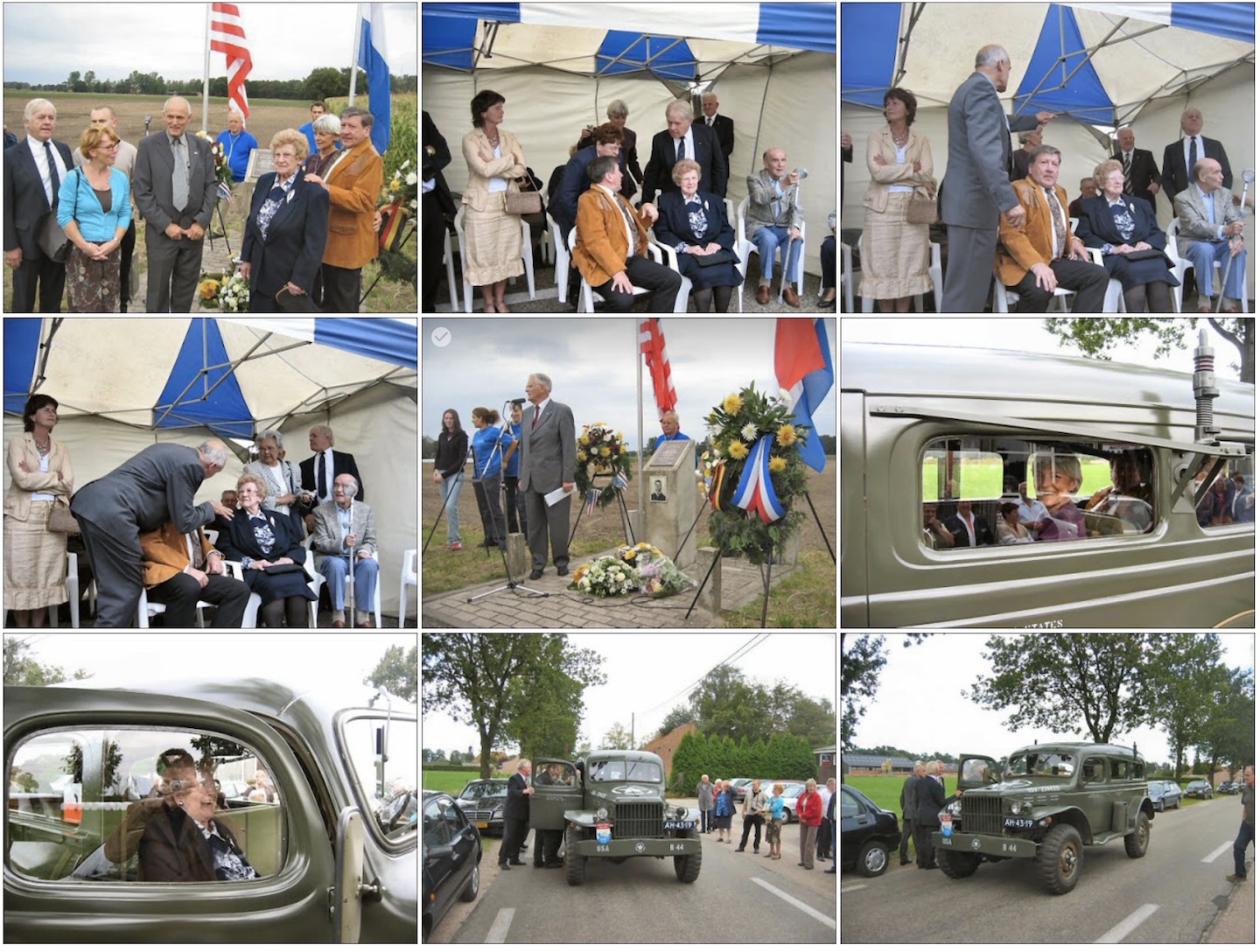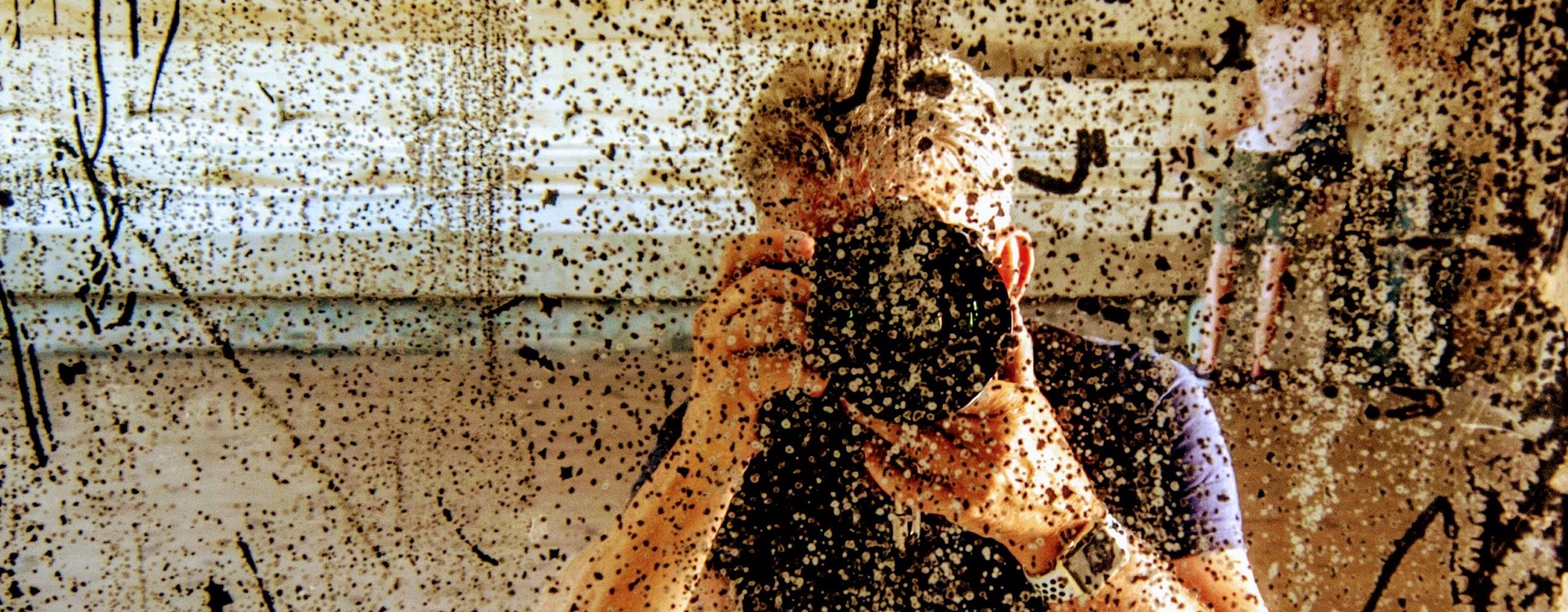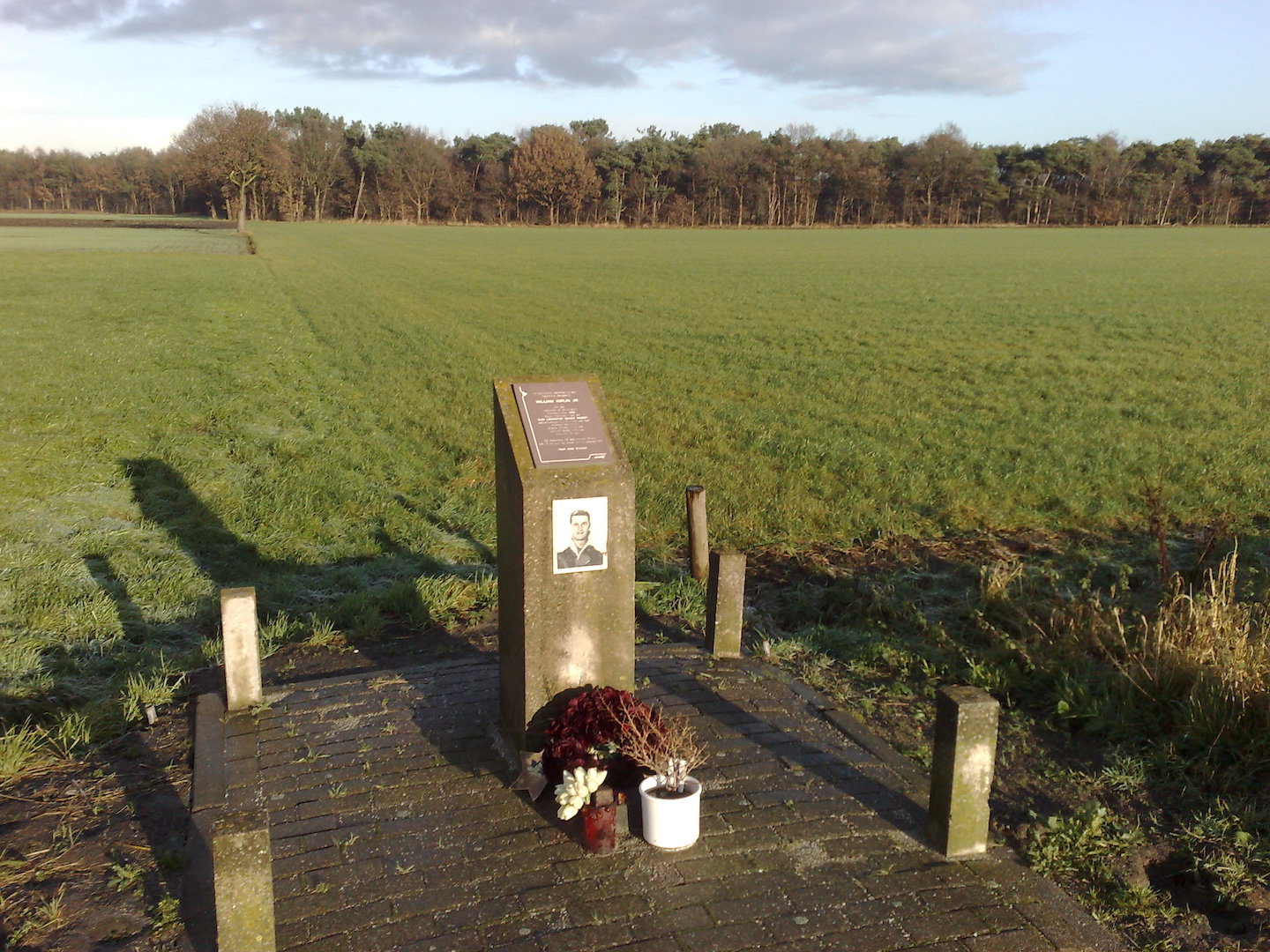On monday september 18, 1944, Maggy Magy crashlanded at Castelre. Approximately fifteen minutes earlier, in the vicinity of Groesbeek, the big Consolidated B24 bomber was hit by flak. Almost sixty years later our reporter visited two of the last survivors of the crew of the Baggy Maggy and the sister of radio-operator Bill Kirlin.
Baggy Maggy was a total loss after the crash. The next day is was set on fire by the Germans who shot it with tracers from a safe distance, while the dead body of Bill Kirlin was stil trapped in the wreckage. It was the end of a reliable workhorse that in the previous two years had earned a lot of respect by the crews who were flying her on missions over France, Holland and Germany. Maggy also took part in the famous raid on the Ploesti oil fields, all the way on the Black Sea coast in Romania.
In september 1944 she was marked by the battles she fought in, a weary but very popular plane, a guardian angel who always brought back her crew. Until she ran out of luck at Groesbeek on september 18, when a shell exploded somewhere under her nose. Commander Larry Hewin, only 19 years (!) old, took glowing red fragments in his legs and neck. While he was lying on the flight deck behind his chair and radio-operator Bill Kirlin was trying to stop the bleeding by applying tourniquets to his wounds, second pilot Richard Scott, aided by flight engineer Donald Dukeman, was frantically trying to keep Baggy Maggy afloat.
Sixty years later it”s a beautiful day in Honeybrook, Pennsylvania. From the living of Donald and Pauline Dukeman the visitor has a view on a fairy-like scene: an Amish farmer ploughing the fields in front of the Dukemans residence. Eight mules alongside, next to each other, the farmer standing on the plough behind them, dressed in traditional costume, hat on his head, long beard. In another meadow next to a little wooden school building it seems like someone is shooting a movie: twenty-odd children in traditional costumes having a good time, playing softball in knee high grass. The scenery looks like another movie, Witness.
“Right”, says Donald Dukeman, who was a rural carrier in Penssylvania Dutch Coutry the last twenty years of his working life, “a few miles down the road, in Strasburg, you can make a phone call in the same booth that Harrison Ford was using in that movie”.
“Scotty told George Sadler to hang on with his full weight on the rudder pedals, while Larry was bleeding to death on the flight deck.
I had to inform the rest of the crew in the waist we were going to crash, by going back through the open bomb bay, because our intercom had been shot out too. It felt like the invisible hand of a giant kept pushing us down. The needles of all indicators, temperature, oil pressure, rotations, were in the red, it was a miracle that we stayed in the air as long as we did.”
By plotting a southwestern course the crew tried to reach a part of Belgium that was liberated by the Allies, but after having passed Baarle Nassau, Baggy Maggy lost het last precious height.
While the screws of the Pratt and Whitneys started to grind sand and potatoes, Baggy Maggy, at approximately 100 miles made a gentle right turn, only to crash hard onto the Hoogstratensebaan, more or less a kind of dike, one meter higher than the potatoe field. Bill Kirlin, who had refused to leave his commander and take his crash position, was crushed and killed by the 300 kilo heavy top turret, that broke loose off the fuselage because of the impact.
“After the crash”, Larry Hewin says two days later in Williamsburg, Virginia, six hours driving south from Dukeman, “for the rest of my life I felt that I was living in extra, in borrowed time. In a way it was very unfair. I was the one that should have been killed by that turret, because I was lying right underneath it, while Bill was taking care of my wounds. At the moment of the crash I was thrown to the front, and Bill was hit by the turret. The nose of the plane was gone, and because the morphine Bill had given me I was able to ran away from the crash, afraid that everything was going to blow up. She didn’t blow because Scotty did such a perfect job. Not only did he manage to put Bagy Maggy down in a such a way that nine out of ten men survived, he’d also killed the master switches during the crashes, so there were no sparks. When I finally sat down on the road, I would not walk for another four months, being in a terrible shape. Arriving in the POW camp in Germany a couple of Englishman were betting that I would not survive to the end of the week.”
For fifty years the members of the crew wouldn’t see each other. In Germany they spent the next eight months in different POW camps, to return to their home country in may 1945. The burned body of Bill Kirlin was buried on the spot of the crash by inhabitants of the area, while two Germans fired a salute. After the liberation it was exhumed and buried again at Baarle Nassau, where is was exhumed again one year later, to be brought to Bill’s final resting spot at the American Cemetry at Margraten in the winter of 1945.
At the Hoogstratensebaan, where Baggy Maggy was crashed, burned and scrapped, and where Bill Kirlin found his first last resting spot, remained only a wooden cross, with a few words on it. After the cross perished around 1955 because of wind and rain, nothing reminded the big bomber that came crashing down from heaven in september 1944.
While the survivors rebuilt their lives in the United States, they completely lost track of each other until 1994. A Hollander, with the tenacity of a terrier, was responsible for the fact that after fifty years they would start to write, and finally meet each other. Jos van Roozendaal is an amateur historian, living about ten kilometers from the crash site in Ulicoten. He got interested in Baggy Maggy when another amateur historian, the late Dr. Ed Loffeld, wrote a series of articles in the weekly newspaper Ons Weekblad in Baarle Nassau. Van Roozendaal himself also mentions the name of Ed Ragas from Belgium: “he knows everything there is to known about waht happenened in the air over here during World War Two. I could not have done what I have done without Ed Loffeld and Ed Ragas”.
Inspired by the articles of Loffeld, Van Roozendaal succeeded in the beginning of the nineties to get in contact with the surviving members of the crew, and to persuade some ot them to come to Holland. Ten years ago, on the fiftieth anniversary of the crash, a new memorial was unveiled at the spot of the crash. Three members of the crew, and Gertrude, youngest sister of Bill Kirlin, were present; bombardier George Sadler, left waist gunner Eugene Shabatura and co-pilot George Scott, the man who landed Baggy Maggy for the last time.
Ten years ago Larry and Barbara Hewin, and Donald and Pauline Dukeman could’nt make it to Holland, due to different reasons. Ten years later Sadler, Shabatura ans Scott have passed away, but Mrs. and Mr. Dukeman as well as Mr.s and Mr. Hewin are happy to receive a reporter from Holland. Mrs. Gertrude Stuber-Kirlin is also still alive and well. Never mind the fact that she is 88 years of age; she’s driving herself from Reading to Honeybrook, bringing long time friend Clyde Hoffa, and arriving with a huge zest for living, as big as her sense of humour, joking and laughing like a twenty year old girl.
Careful she unpacks a touching peace of work: the diary she started to maintain when her kid brother, the apple of his elder sisters eyes, was still in high school, the book following the rest of his too short life. His work as bookkeeper at a textile machine producer in Shillington, leaving for the service, being trained as a radio operator. Pictures of Bill between his classmates at high school, at the service, in a baseball uniform. The first postcards he sent from his base in England, his last letter, the official statement of his missing in action, the offial death announcement , the obituray notice in a local newspaper, a picture of the memorial stone at the wall of the textile works.
“I was the youngest sister” says Mrs. Stuber-Kirlin, the other sisters were a few years older when he was born, wich is a considerable difference when you are so young as we were, so we grew up together, being very close to each other. I still miss him very much”.
Donald Dukeman also shows beautiful memorabilia an collectors items; log books, a model of Baggy Maggy, the heavy and thick B24 manual with the accuracte descritions of thousands of parts that he, once a flight engineer, still knows inside out.
One of the cornerstones of his library, just as Larry Hewins study a miniature flight museum in his own right, is The Baggy Maggy File. A thick ring binder, a life’s work of Jos van Roozendaal, a work that cries out to be published, a possible bestseller. Or at least to be digitised and to be publisehd on a website.
The Baggy Maggy File is a fascinating report of what happened on september 18, 1944, on the months leading to that date, and in the sixty years thereafter. The training of the crew in America, life on airfield Hardwick in England, hardship and deprivation as prisoners of war in the camps in Germany, the ever present humour, the deathmarch Dukeman had to walk.
Is also reads as a detective about the search for the survivors that Jos van Roozendaal started somewehere around 1990. To be able to better communicate with his new American friends he qualified in nightly hours for a certificate in English. His Americans became friends for life, and they speak about him with immense respect and a lot of warmth.
Where searching for whatever who or what these days is relatively simple because of the internet, Jos van Roozendaal simply had to make do something, and wait. Numerous letters to veterans organizations, airbases, telephone calls, and then wait again.
“After each letter I had to wait at least yet another couple of weeks”, says Van Roozendaal, “until finally I got my breakthrough when a retired colonel passed my letters on to some members of the crew”.
Only a few weeks ago he was presented with an unexpected gift: on of the hatches through wich one of the two waist gunners aimed his machine gun at German fighters. “Baggy Maggy didn’t burn completely after the Germans set if on fire. The reason for that was that they’d first removed all valuables, including the precious fuel. Before the remains were scrapped, people in the area salvaged a lot of things. A 14-year old farmhand took the hatch. Now that he is 74, he has given it to me”. The big wheels of the main landing gear of Baggy Maggy served another farmer well way into the sixties, until they finally disintegrated; he used them to haul timber from woods surrounding the crash site.
Repeating part of the Baggy Maggy File is Borrowed Times, the magazine that Larry Hewin started to publish at irregular intervals after he was reunited with his crew, thanks to Van Roozendaal. Other parts of the file are the impressive essays in which Larry Hewin and Donald Dukeman are writing about their time at war. Hewin, after he started Borrowed Time, clearly started to like writing more and more, Dukeman started his file because his children and grandchildren kept asking him about his past.
Where Hewin, with a lot of humour playing with words, has a knick for writing, de power of the religious Dukeman is the simple but efficient way in which he has finally buried his wartime past. “You also have to consider”, says Van Roozendaal, “that Donald had an even worse time in prison camp than Larry did. At the end of the war he barely survived that terrible deathmarch from north to south Germany.
Hewin, “Big Larry”, was nineteen when he was appointed as commander of a B24. Form the very first moment he saw one, it was hate and love: “I hate the plane, but I loved the engines. She was an unruly monster to fly, but those Pratt and Whitneys kept spinning forever. They brought you home, even if they were shot to pieces”.
To what happened in 1994 and 1945, and to his life in borrowed time, Larry Hewin has derived something that has stayed with him until now, close to his 80th birthday. “I’ve never been afraid to die anymore, everything was a bonus. It all went so fast back then. As it happened I flew my crew in a brand-new B24 all the way from Lincoln, Nebraska, via Nova Scotia and Iceland to Scotland. In England we had to turn her in and then I flew all kind of missions in different machines over Holland, France and Germany. Bombing missions, and supply missions, like the one that finally got us shot down over Holland. I was seriously wounded, almost killed, couldn’t walk for months, was brought to Germany, spent the remaining eight months of the war in different camps, after the liberation to camp Lucky Strike in France, shipped back to the US, and I was back in Texas before my 21th birtday. I wasn’t alsways fun, but I wouldn’t have missed it. I’d like to hink is has made me a better man”.
While Jos van Roozendaal is pushing to get a memorial service going in september, it is not very likely that Larry Hewin or Donald Dukeman will be able to attend, due to fysical problems, infirmieties of old age. But Gertrude Stuber-Kirlin hardly can’t wait to hear a date; “Of course I will be there when they do something. I am morally obliged to do so. Obliged to Jos van Roozendaal, to the people of Castelre and Ulicoten, to everybody in Holland. It is unbelievable how you people over there have kept Bills memory alive. If God is willing, I definitely will be there in september…”.



